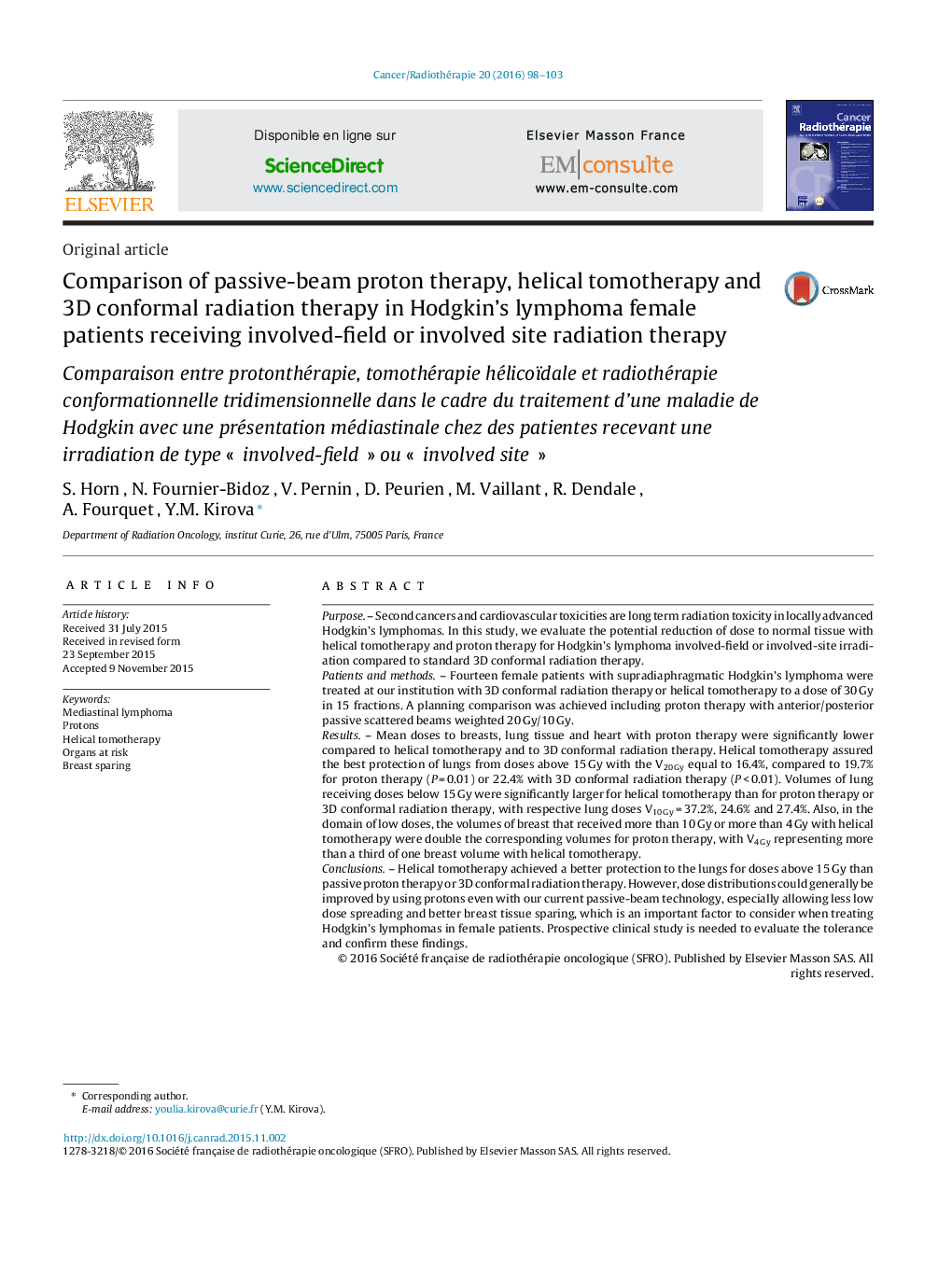| کد مقاله | کد نشریه | سال انتشار | مقاله انگلیسی | نسخه تمام متن |
|---|---|---|---|---|
| 2117019 | 1085191 | 2016 | 6 صفحه PDF | دانلود رایگان |

PurposeSecond cancers and cardiovascular toxicities are long term radiation toxicity in locally advanced Hodgkin's lymphomas. In this study, we evaluate the potential reduction of dose to normal tissue with helical tomotherapy and proton therapy for Hodgkin's lymphoma involved-field or involved-site irradiation compared to standard 3D conformal radiation therapy.Patients and methodsFourteen female patients with supradiaphragmatic Hodgkin's lymphoma were treated at our institution with 3D conformal radiation therapy or helical tomotherapy to a dose of 30 Gy in 15 fractions. A planning comparison was achieved including proton therapy with anterior/posterior passive scattered beams weighted 20 Gy/10 Gy.ResultsMean doses to breasts, lung tissue and heart with proton therapy were significantly lower compared to helical tomotherapy and to 3D conformal radiation therapy. Helical tomotherapy assured the best protection of lungs from doses above 15 Gy with the V20 Gy equal to 16.4%, compared to 19.7% for proton therapy (P = 0.01) or 22.4% with 3D conformal radiation therapy (P < 0.01). Volumes of lung receiving doses below 15 Gy were significantly larger for helical tomotherapy than for proton therapy or 3D conformal radiation therapy, with respective lung doses V10 Gy = 37.2%, 24.6% and 27.4%. Also, in the domain of low doses, the volumes of breast that received more than 10 Gy or more than 4 Gy with helical tomotherapy were double the corresponding volumes for proton therapy, with V4 Gy representing more than a third of one breast volume with helical tomotherapy.ConclusionsHelical tomotherapy achieved a better protection to the lungs for doses above 15 Gy than passive proton therapy or 3D conformal radiation therapy. However, dose distributions could generally be improved by using protons even with our current passive-beam technology, especially allowing less low dose spreading and better breast tissue sparing, which is an important factor to consider when treating Hodgkin's lymphomas in female patients. Prospective clinical study is needed to evaluate the tolerance and confirm these findings.
RésuméObjectif de l’étudeLa toxicité la plus importante dans le cadre du traitement d’une maladie de Hodgkin est le cancer secondaire et cardiovasculaire. Cette étude a porté sur la réduction des doses dans les tissus normaux avec l’aide des nouvelles techniques comme la tomothérapie hélicoïdale, la protonthérapie et la radiothérapie conformationnelle tridimensionnelle chez des jeunes patientes recevant une irradiation de type « involved-field » ou « involved site ».Patientes et méthodesQuatorze femmes atteintes d’une maladie de Hodgkin avec une présentation sus-diaphragmatique ont reçu une tomothérapie hélicoïdale ou une radiothérapie conformationnelle tridimensionnelle de 30 Gy en15 fractions. Une comparaison dosimétrique a été réalisée entre la protonthérapie, la tomothérapie hélicoïdale et la radiothérapie conformationnelle tridimensionnelle.RésultatsLes doses moyennes délivrées dans les seins, les poumons et le cœur ont été réduites avec les protons en comparaison avec la tomothérapie hélicoïdale et la radiothérapie conformationnelle tridimensionnelle. La tomothérapie hélicoïdale a montré une meilleure protection pulmonaire avec un volume recevant 20 Gy (V20 Gy) de 16,4 % pour, contre 19,7 % pour les protons (p = 0,01) et 22,4 % avec la radiothérapie conformationnelle tridimensionnelle (p < 0,01). En même temps, les volumes irradiés avec des doses de moins de 15 Gy étaient plus importants avec des volumes recevant 10 Gy (V10 Gy) respectivement de 37,2 %, 24,6 % et 27,4 % pour la tomothérapie hélicoïdale, la protonthérapie et la radiothérapie conformationnelle tridimensionnelle. Dans le domaine de faibles doses, les seins recevaient plus avec la tomothérapie hélicoïdale (le volume recevant 4 Gy, V4Gy, représentait plus d’un tiers du sein) qu’avec la protonthérapie.ConclusionsLa tomothérapie hélicoïdale obtient une meilleure protection pulmonaire pour les doses supérieures à 15 Gy que la protonthérapie et la radiothérapie conformationnelle tridimensionnelle, mais la distribution des doses peut être améliorée par l’utilisation de protons, pour mieux protéger les seins. Une étude prospective est nécessaire pour confirmer ces données dosimétriques.
Journal: Cancer/Radiothérapie - Volume 20, Issue 2, April 2016, Pages 98–103